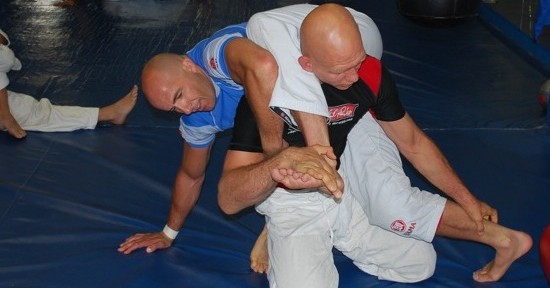 How hard should you go in sparring?
How hard should you go in sparring?
That’s a good question!
At one end of the spectrum you have light, relaxed and friendly sparring. And at the other end you have fights to the death that would make Roman gladiators proud.
I once asked a Judo coaches whether I should go light or hard in the sparring part of class, and his answer has stuck with me ever since.
“Both!” he said. “You need to have both kinds of sparring in your curriculum to develop as an athlete. The hard sparring makes you tougher, and the light sparring makes you more technical.”
I think it’s great advice that applies to every pressure tested martial art including grappling arts like BJJ, Judo, and Sambo, striking arts like Boxing, Muay Thai, and Kyokoshin, and weapon arts like Kali, Escrima and Kendo.
You spar at different intensities depending what you want to get out of that sparring session.
Light Sparring for Technical Development
First, let’s talk about going light in sparring, and then we’ll move on to grappling…
It’s pretty obvious to go easy when you’re first getting introduced to sparring. Going light with a sane partner gives you a chance to figure out what’s happening and learn what you should be doing without getting injured.
What does this look like in practice?
Well, in a kickboxing context here’s a clip from the Precision Kickboxing Masterclass in which kickboxing coach Ritchie Yip breaks down the so-called ‘Susan Drill’, the first stage of the sparring progression in striking.
As you saw, you go ridiculously light at first. Don’t worry, you won’t stay at this level forever, but you have to hone your skills before you start having battles of wills.
You can apply the same concept of going light in grappling sparring too.
How do you do this? Easy.
First the “don’ts”.
Don’t use full strength, don’t use full speed, don’t hang onto something for dear life and don’t drop all your weight onto your opponent.
Then the “do’s”.
Do let your opponent move, do let him apply his techniques, do try to flow and keep on moving, and do be prepared to tap if you get caught in something.
Ryron Gracie once called this, “keeping it playful”. It’s simply much easier to refine your skills and develop new skills when you’re keeping it playful than if you’re going full force..
But going light is NOT just for beginners. It’s something more advanced students should do as well, and preferably they should do it all the time
That’s because going light lowers the cost of failure.
Let’s say you and I are grappling and I want to try out a new guard guard retention movement (a defense against the guard pass). You start in my guard, I try the move, it doesn’t work, so you pass my guard and then spend the rest of the round mauling me.
In a 5 minute round I got to try out that new technique (the guard retention movement) exactly one time. How am I going to get better if I only get one chance to try that new move every time we spar?
Also getting mauled every time you try a new move is a strong disincentive to never go outside your comfort zone. And if you always stay in your comfort zone then you’re never going to grow as a martial artist.
There are number of ways to lower the cost of failure when you’re sparring on the ground. Go a bit slower, don’t use as much strength, and don’t drop your weight fully. You’re in my guard…. I try my move… you pass my guard… I’m pinned but you stay light on my body allow me to escape… I reestablish guard… and now I can try that move again.
You can also lower the cost of failure by heavily constraining the situation. You only spar one position, one submission, or one technique for the whole round. If you succeed, or if your opponent escapes, then you reset and go again. This really takes the ego and much of the crazy intensity out of a match, making it much more about the learning.
Here’s Rob Biernacki from The Submission Formula with one of his training methods you can use to lower the cost of failure when it comes to training the Kimura submission…
Hard Sparring to Develop Grit
So we’ve covered some reasons to train light, and shown you some training methods to do it.
Let’s go to the other end of the spectrum and talk about hard sparring…
This is when two guys throw bombs at each other in the boxing ring, or two grapplers trying to choke each other until their hands go white. I’m talking about having those knock down, drag out brawls that leave you sore, exhausted, and put-a-fork-in-it done.
And you DO need to train like this, at least occasionally.
Pushing yourself to the limit in reasonably safe situations is how you develop mental and physical toughness. You’ll learn that you can continue to function when you’re uncomfortable, keep on going when you’re exhausted, and not give up even when your ass is getting thoroughly kicked.
I’m a big fan of strength and cardio training, but ultimately the best form of martial arts conditioning is that martial art itself, executed at high levels of intensity.
If you’re a competitor then HARD sparring with someone roughly your level is the best way to simulate competition.
On my podcast I asked UFC legend Oleg ‘The Russian Bear’ Taktarov about his toughest fight ever; he said that it wasn’t so much the fight itself, but rather the sparring to get ready for the fight that was tough…
Ultimately we don’t train because it’s easy… we train because it’s hard. Training hard is a transformative experience that shows you how much more you’re capable of than you though, and this newfound toughness carries over to the rest of your life.
That being said, there are definitely downsides to always going hard in sparring…
We’ve already discussed how you might miss out on refining your skills and developing new techniques if you’re always training in life and death mode.
https://www.youtube.com/watch?v=0JCr6EfleG8https://www.youtube.com/watch?v=0JCr6EfleG8But there’s also a limit to how much hard training you can do. Going hard all the time reduces the sheer volume of training you can do.
Many of the top BJJ competitors spend 5 to 6 hours a day on the mat, but that doesn’t mean they’re going hard that entire time. They’re mixing drilling with situational sparring with light sparring and harder sparring. If they were going all out the whole time then invariably they’d get sick and injured very very quickly.
The sad fact is that harder you spar then the greater the risk of injury you face, and injury is the enemy of progress.
In grappling arts the injuries are mostly orthopedic, ranging from a mild sprain that you have to work around, to dislocations and breaks that might require extensive surgery and physiotherapy. All of which sucks.
But when it comes to the striking arts the danger of going hard is much more severe.
Getting hit in the head is incredibly dangerous in the long term. Chronic traumatic encephalopathy (or CTE) is a major concern in any sport that involves violently sloshing your brain around in its braincase.

Your brain is a jelly filled with about 100 billion tiny neurons (and 100 trillion synapses between those neurons). To squeeze that much computing power into your head that machinery needs to be insanely tiny and delicate. This is why so many boxers have brain damage.
It is the great tragedy of the striking arts that you need to get hit in the head to get better.
Think of it this way… If I told you that you could only have ONE smartphone for the rest of your life, that you could never repair or replace it, then how paranoid would you be with it? Would you be dropping it on the floor or allowing your buddy to punch it with a gloved hand? Of course not.
Your brain is infinitely more complex than your smartphone. And given that they can’t do brain transplant surgery yet, it’s also completely irreplaceable, so why are we so cavalier about full contact sparring?
You may decide that you’re willing to take the risk to get better at striking – I know that I rolled the dice and did a lot of hard sparring in my youth.
But you can also moderate how often you spar and try to get as much benefit as you can out of shadowboxing, equipment training and drilling first, and then only spar occasionally. More and more MMA fighters are choosing this route – sparring with head contact only once a week say – and I don’t think the skill level in that sport is going down.
Full contact sparring in striking should be something you do rarely. Just often enough to test yourself, become comfortable, and test your conditioning. Hhopefully not often enough do real damage to your brain.
Sparring hard and sparring easy are two different things, and you need to do both.
You need to go hard once in while to develop grit, confidence and to really test your conditioning.
And you need to go light refine your technical skills, develop new skills, and be a decent training partner for other people.
Stephan Kesting
Additional Resources
How to Make Sure Your Martial Art Will Work in the Street
Here’s a video and associated article talking about the 5 levels of training – from solo training to full contact sparring – that ensure you can rely on your techniques when you need them the most.
Too Deadly to Spar?
Are you being told that your martial art is just too deadly to train against resistance? C’mon, gimme a break…
How to Train Eye Gouges, Throat Grabs and Groin Strikes
Here’s what you can do to have confidence in the more ‘deadly’ techniques of your martial art
